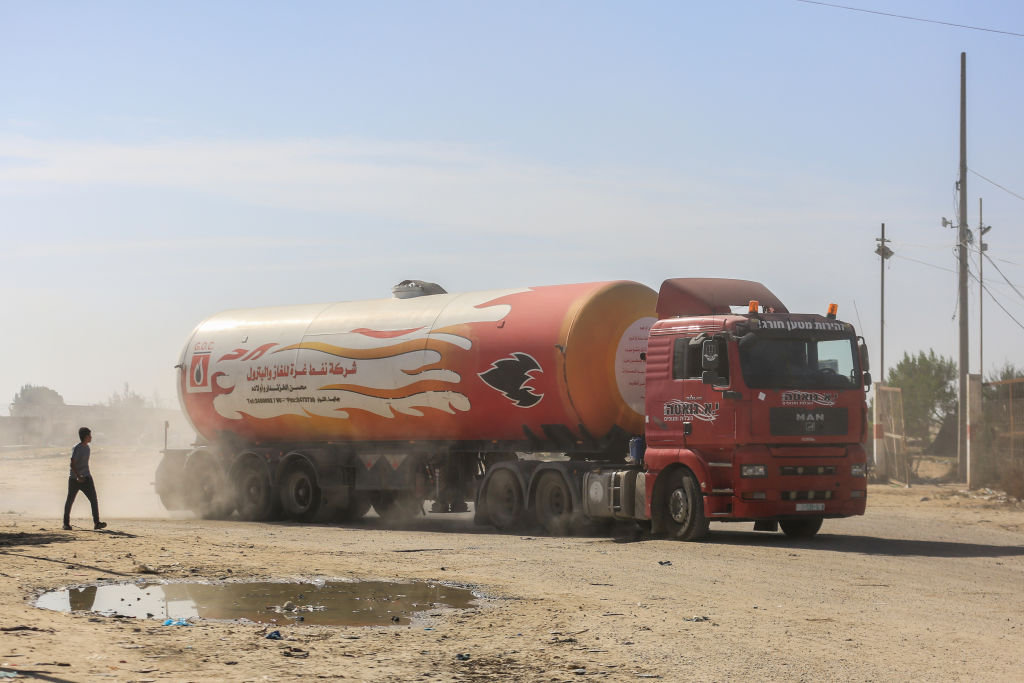
Additional humanitarian aid trucks started rolling over the Rafah Crossing from Egypt to Gaza early Friday morning, as the planned four-day ceasefire began. The aid trucks, fuel tankers among them, were a welcome sight amid the seven-week-long war between Israel and Hamas.
Since Hamas attacked Israel on Oct. 7, killing 1,200 people and taking more than 200 hostage, Israel has periodically cut off water, fuel and electricity to Gaza. An estimated 14,000 people have been killed by Israeli bombardment of the territory, the Hamas-run health ministry has said.
People in Gaza experienced reprieve on Friday after the warring sides implemented a new deal that included a temporary pause in fighting, delivery of more aid, and the planned exchange of a possible 50 Hamas hostages for 150 Palestinian prisoners held by Israel.
International organizations and Qatar’s foreign minister, who helped broker the deal, have said the new aid will not be enough to address the dire humanitarian disaster in Gaza. More than half of the territory’s two million-plus residents are internally displaced, with food and clean water now running out in north Gaza.
The United Nations and many aid groups have been calling for a permanent ceasefire.
Israel’s Prime Minister Benjamin Netanyahu has said that the country will continue its war to eliminate Hamas after the truce. Hamas told Al Jazeera in an interview that they want a permanent ceasefire, but said the group is “ready to deal with all situations imposed by Israel.”
What aid is entering Gaza?
Between Oct. 21 and Nov. 23, more than 1,723 truckloads of humanitarian supplies entered Gaza through the Egyptian border, the U.N. said. Before the war, a monthly average of nearly 10,000 trucks of commercial and humanitarian commodities came in.
The U.N. said Israel allowed 19,812 U.S. gallons (75,000 liters) of fuel to enter Gaza on Nov. 23. Israel had previously prohibited fuel over fears it would be used by Hamas for military purposes. Fuel is now being distributed by the U.N. to support food distribution and to operate generators at hospitals, water and sanitation facilities, shelters and other critical services, the agency said.
The Israel Defense Forces said in a statement shared on various social media channels that four tankers of fuel and four tankers of cooking gas were transferred from Egypt on Friday morning.
Videos showed more trucks started passing into Gaza after the temporary ceasefire started at 7 a.m. local time.
As of 10:30 a.m., 60 trucks of a total of 230 expected on Friday had entered Gaza, Al Arabiya reported, citing a Rafah crossing border official.
The Palestinian Red Crescent received two ambulances and 85 trucks loaded with aid through the crossing, carrying food, water, relief items, medical equipment, and medications, the group wrote on X (formerly Twitter).
On Nov. 25, the IDF shared a post on social media, detailing its own record of the aid distributed in Gaza the previous day.
"200 trucks with humanitarian aid entered Gaza yesterday, via the Rafah Crossing, and were delivered to international aid organizations, as part of the framework for the release of the hostages, as agreed with the U.S. and mediated by Qatar and Egypt," the update read.
The statement went on to say that 124 trucks were for carrying food, 18 for medical supplies, 38 for water, 17 for shelter supplies, four each for gas and fuel, and an additional three for hygiene supplies.
"Approximately 200 trucks carrying humanitarian aid are expected to enter Gaza today," the IDF said.
What is the humanitarian crisis in Gaza?
Dr Majed Al-Ansari, Qatar’s foreign ministry spokesperson, told The Independent that the international community needed to allow unrestricted aid to address the scale of the crisis.
“There are unbelievable levels of destruction, death and violence that we have not seen before,” he was quoted as saying. “This is not something that you can remedy with any number of trucks of aid that go in.”
The U.N. reported on Friday that people have resorted to eating raw vegetables or unripe fruits, with no bakeries operational in north Gaza. Three children, including a baby in an incubator, reportedly died at a hospital Wednesday because of lack of electricity, the agency said.
Multiple U.N. agencies have called for a humanitarian ceasefire, with U.N.’s Secretary-General saying in a statement on Nov. 19 that “this must stop.”
In a news conference Friday morning, Jens Laerke, spokesman for the U.N. humanitarian agency OCHA, told reporters: “We hope that this humanitarian pause leads to a longer term humanitarian ceasefire for the benefit of the people of Gaza, Israel and others.”
World Health Organization spokesperson Christian Lindmeier said during the news conference that the agency remains “extremely concerned about the safety of the estimated 100 patients and health workers remaining at Al-Shifa,” a hospital in north Gaza that was the center of a recent Israeli ground operation.
Lindmeier said WHO, along with the Palestinian Red Crescent, evacuated 151 patients, relatives and health workers from Al-Shifa on Nov. 22. That included 73 severely ill or injured patients, 18 dialysis patients, 26 with serious spinal issues, two in need of critical care and 19 in wheelchairs, he said. He didn’t know exactly how many remained at the hospital.
About 200 patients and staff also remain at the Indonesian Hospital in north Gaza, the U.N. said.
More Must-Reads from TIME
- Cybersecurity Experts Are Sounding the Alarm on DOGE
- Meet the 2025 Women of the Year
- The Harsh Truth About Disability Inclusion
- Why Do More Young Adults Have Cancer?
- Colman Domingo Leads With Radical Love
- How to Get Better at Doing Things Alone
- Michelle Zauner Stares Down the Darkness
Contact us at letters@time.com